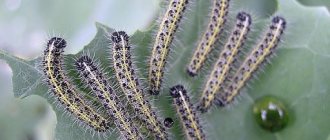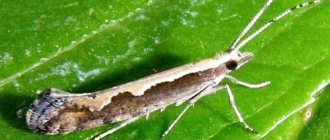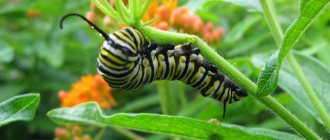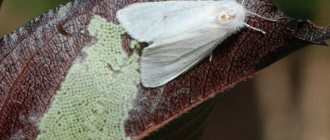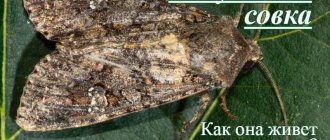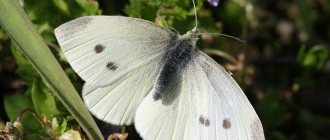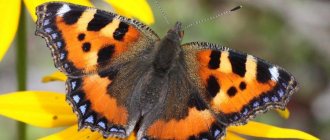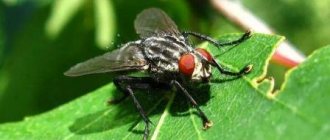Cabbage Garden
Cabbage butterfly (cabbage white butterfly): description, life cycle, how to deal with the pest
Cabbage Garden
Most people have known the cabbage butterfly since childhood. This insect is considered one of the most common butterflies living in central Russia. In terms of popularity, only urticaria can compete with it. For some people, the appearance of butterflies marks the beginning of summer and warmer days, but gardeners are well aware of the danger posed by these insects.
Reproduction and development
Reproduction in this species is bisexual and the female needs a male to fertilize the eggs. Before mating, the male and female fly together up to 100 meters. The development of the cabbage butterfly has four stages:
- egg;
- larva (caterpillar);
- chrysalis;
- adult butterfly.
The eggs laid by the female have pronounced ribbing and an elongated barrel shape. The length of each egg is 1.25 mm. Already after 7-10 days from the moment of laying, movement is visible in them and small larvae begin to hatch. The body length of the larvae is only 1.75 mm and their first food is the egg shell. The larva of the cabbage butterfly has a green (ocher) color, a black head and is highly viable.
Compared to the rest of the body, the larva's head is very hard with serrated jaws. Immediately after hatching, the caterpillars stay in groups, eating the shell and pulp of the cabbage leaf from the back side. During this period, cabbage butterfly caterpillars eat little. However, as soon as they get stronger, they spread to the sides. Their appetite becomes insatiable, and they make entire holes in the leaf.
Cabbage larvae are voracious and become a real disaster for gardeners if they are not dealt with. With their powerful jaws, they eat cabbage leaves, leaving only hard veins. The lifespan of the caterpillar is several weeks, but during this time they are capable of completely destroying the crop. Unlike adults, larvae have very poor eyesight and see no further than one centimeter, so in search of food they rely only on their sense of smell. Their eyes are very small and do not have the complex structure of an adult butterfly.
During the caterpillar's life span, it experiences 4 molts. Usually the first three times this process lasts about a day, but the last, fourth molt can last up to 40 hours. Between molts there are 3 to 7 days. In warm and dry seasons, caterpillars develop faster than in the rainy season. Before molting, the caterpillar stops eating and moving, remaining motionless for some time after its completion.
Expert opinion Nina Lukina
In caterpillars, the body covers do not grow with them, so molting is a very important process. The peculiarity of caterpillars is that they do not grow continuously. They can grow only after molting, while the body cover is relatively soft and capable of stretching. By the time of the first molt, the body length already reaches 1.7 cm. During the period from the first to the second moult, the caterpillar actively grows. By the fourth molt, it grows to 3.5-4 cm. Having reached this size and having eaten well on cabbage leaves, the adult caterpillars move to trees and fences.
In total, the cabbage butterfly spends from 17 to 30 days in the caterpillar stage. After the completion of the fourth molt on days 7-10, the caterpillar pupates. It secretes a web, with which it attaches to the surface of a tree trunk, climbing to a height of up to six meters. Belted with a belt made of cobwebs, it hangs freely in a vertical position with its head up. You can find them everywhere:
- on the trees;
- fences;
- bushes;
- barn walls.
Black and orange spots are scattered throughout the greenish-yellow body of the pupa. The pupa tends to take on the color of the surface on which it is attached. On a light fence or wall of a building it will be light, on a dark tree bark it will be dark. The cabbage plant stays in this stage for 8 to 17 days, depending on the ambient temperature. The warmer it is, the shorter the transformation process lasts. Spring and summer pupae differ from autumn ones.
The most optimal temperature for the development of cabbage is in the range from 20 to 26 degrees. In addition, whites do not like high humidity. Under favorable conditions, the young butterfly appears two weeks after pupation. It differs from adult individuals in being slightly smaller in size. Butterflies that appear in summer have black markings and spots on their wings that are brighter than those of spring representatives of the species.
If climatic conditions in summer are not favorable (cold, rainy), the cabbage caterpillar turns into a diapasing pupa. The butterfly will fly out of it only next spring, when the air warms up to a temperature of at least 20 degrees. If pupation occurs early or mid-season, a new butterfly emerges from the cocoon and gives birth to another generation. If it pupates in September, the cabbage weed goes into hibernation and waits out the winter in a cocoon, awakening only in the spring.
Cabbage life style
The white butterfly is a very active insect and migrates a lot. Cabbage grass is most active from April to mid-October. If the insect’s region of residence is warm enough, it can produce up to three offspring per season.
The butterfly does not fly at night; it is a completely diurnal resident. Peak activity occurs on warmer days when there is no rain. The insect does not like windy weather.
It is believed that white grass greatly harms gardeners. In fact, adults do more good than harm by pollinating plants.
Features of the development of cabbage whites
The flight of butterflies begins in early spring - under favorable weather conditions this happens as early as April. They lead a diurnal lifestyle, becoming especially active on sunny and hot days. Windy weather is poorly tolerated. Usually found near cabbage plantations. The optimal temperature for normal development is considered to be 20-25°C.
Females lay eggs on the underside of the leaf in groups of 20-200 pieces. After 1-2 weeks, caterpillars emerge from the eggs, which at first stick together. They feed on the pulp of the underside of the leaves, while the upper skin remains untouched.
After some time, the caterpillars disperse throughout the plant and eat leaves mainly from the edges. Adults are found mainly on the upper part of the leaves and, as a rule, damage them very badly. The caterpillars' diet includes cabbage, radishes, rutabaga and other cruciferous plants. In addition, they eat plants of other families. These can be nasturtium, mignonette, capers.
Eggs are laid by butterflies of the new generation in July-August. The development of the second generation of caterpillars occurs en masse, provided that the first generation has not been destroyed by vegetable growers. In the southern regions, cabbage whiteweed can develop 3-5 generations in one season if there is no control over it.
Butterfly White cabbage (Cabbage). insect pest
04/26/2017 In total, about one hundred thousand species of different butterflies live on earth, and each is beautiful in its own way. The inhabitants of Ancient Rome, seeing the unusual beauty of these insects, believed that butterflies originated from flowers that broke away from plants.
Most butterflies feed on nectar, and some species benefit by pollinating flowers.
Belyanka Cabbage
also carries flower pollen on its shaggy body, thus pollinating flowers and plants, but its harmful offspring, which are commonly called caterpillars, nullify all its merits.
Adult insect (imago)
Cabbage White Butterfly
(
lat. Pieris brassicae L.
) has a rather large size. Males of this species of butterflies can reach a wingspan of five and a half centimeters, and the female’s wings reach even six.
The butterfly flies unevenly, spasmodically, and this manner of flight makes it difficult prey for predatory bird species. Having settled on a flower, the insect folds its wings and immediately becomes invisible, completely merging with the plant, which also complicates the hunt for them.
Distinguish Cabbage Whiteberry
from other butterflies it’s easy. Males have characteristic black corners on their fore and hind wings (the upper areas of which are cream or white). The female insect also has dark corners, as well as two black round spots that are located on the front wings. The lower part of its wing is painted a pale greenish shade with black speckles. If you touch the wings with your fingers, pollen will remain on them and the wings will lose their original color.
The insect's body consists of three parts: head, thorax and abdomen. On the head there is a proboscis twisted into a spiral, which the butterfly straightens to get the sweet juice from the flower. The proboscis indicates that this method of feeding the butterfly is predisposed only to receiving liquid food (nectar).
At Cabbage Belyanka
vision is well developed (large round eyes are located on the head) and sense of smell, which allows her to excellently navigate in space. The organs of smell and touch are long, sensitive antennae with small thickenings at the ends.
The main habitat of the insect is meadows and fields. Cabbage
can be easily found on the edges, in gardens, and clearings.
Butterflies are able to rise to a height of up to twenty meters and reach a flight speed of about twenty kilometers per hour, thanks to which they migrate safely from one place to another, while covering significant distances and are thus able to travel from country to country.
The mass emergence of adult butterflies usually begins in April - May. The warmer the weather, the earlier the deadline. They fly during the daytime and feed on flower nectar, preferring plants of the cruciferous family.
They are especially active on a warm sunny day.
Cabbage White Butterflies
usually so numerous that males do not need to go on a long journey in search of a partner to find females. The male emits a strong odor reminiscent of geranium, which is how the adult female butterfly finds him.
Before the mating process occurs, the couple flies together for some distance (more than a hundred meters), which is very reminiscent of the scene of dating and courtship.
Soon after the female Belyanka
begin to lay eggs, placing them on the underside of a cabbage leaf or on other cultivated cruciferous families (rutabagas, radishes, turnips, radishes, rapeseed, horseradish, as well as nasturtium and garlic).
Being located at the bottom of the leaf, the eggs are well protected from exposure to the sun, rain and are invisible to predators.
The butterfly finds the required plant for laying by smell. This was proven during the experiment: if you generously smear the fence with fresh cabbage juice, the stupid cabbage weed will immediately lay eggs even on it.
Egg
Eggs are located on the leaf in groups of fifteen to one hundred pieces (under favorable conditions, the number can reach up to two hundred pieces in each clutch).
The eggs are cone-shaped with longitudinal ribs. The color is rich, yellow, and in appearance the embryos resemble small, squat barrels, just over a millimeter in height.
Caterpillar
Soon (after about a week) the larvae hatch from the eggs. Their main function is to accumulate the necessary resources to ensure their next winged incarnation, which is why the caterpillars are extremely voracious. Because of their insatiability, they are popularly called “ cabbage worms.”
"or "
cabbage caterpillar
."
The hatched larvae live in a colony and immediately begin to feed, scraping off the delicate skin and pulp from the underside of the leaf.
Soon the pests spread throughout the plant, gnawing leaves from the edges, and as they grow, they can severely damage them, leaving only rough veins.
If there are a lot of larvae, they can completely destroy an entire head of cabbage in just a couple of days.
During development, caterpillars molt three to four times.
Cabbage Caterpillar
has a greenish-gray color, which also has yellow stripes with dark spots. They have a yellowish stripe on the sides, a lighter stripe along the back, and the whole body is covered with small bristles.
As they grow, they change color, becoming blue-green with narrow yellow stripes and black dots on the sides and back. This protective coloring on a cabbage patch makes the caterpillar secretive.
Cabbage larvae
They have a chitinous covering and tenacious abdominal legs, which allows the caterpillars to crawl freely along the surface of the leaves. The strong gnawing jaws move constantly, allowing the caterpillar to bite and chew hard plant tissue.
Adult caterpillars can reach four centimeters in length.
Depending on weather conditions, insects remain in the caterpillar phase for about two to three weeks. Then they leave the plantation with gnawed plants and crawl onto trees, fences, and walls of buildings. Having settled in a secluded place, with the help of spider threads the caterpillar is securely attached to a solid base in order to turn into a pupa.
Soon the caterpillar envelops itself in a silk thread and freezes. If the cocoon is produced in August and the weather conditions are unfavorable, the pupa in this form survives the entire winter so that in April it will be reborn into an adult (imago).
Doll
The pest's pupa has an angular shape with a yellowish-green color, on which there are black spots (on the back and sides). There are soft tissues inside it.
On average, it takes about a couple of weeks for a pupa to develop into an adult insect.
When the time comes, the skin bursts and an adult butterfly emerges from the pupa. Once her wings harden and expand, she gains the ability to fly, mate, and lay eggs.
White Butterflies
the second generation produces further offspring in July - August. The second generation of pests develops en masse, provided that the fight against the first generation was not carried out at all or the measures turned out to be ineffective, and then a new massive wave of pest invasion occurs.
Usually per season Cabbage
manages to produce two offspring, but under favorable weather conditions (with a warm and long autumn), the pest is able to complete a third development cycle, which lasts from September to October.
Methods to combat cabbage
The simplest (and also the most labor-intensive) way to combat larvae is to collect the caterpillars by hand and then destroy them. If the pest is in danger, it immediately curls up into a ring and rolls off the plant onto the ground.
Preventive methods:
To prevent infection of cruciferous crops by cabbage
, it is necessary to periodically inspect plant leaves from the underside of the leaf and, if possible, destroy all found clutches with eggs.
Another preventative method of combating Cabbage
is the destruction of its pupae. For this purpose, it is necessary in the spring to carefully inspect their possible wintering sites (tree trunks, dry branches, fences, walls of barns and other buildings).
Cleaned tree trunks must be whitened in the spring.
Agrotechnical methods:
First of all, it is advisable to plant cabbage as early as possible, even before the mass flight of butterflies.
To combat the pest, it is necessary to thoroughly remove cruciferous weeds from the plantation. Plants such as “shepherd’s purse”, “colza”, “yarutka” attract pests. Conversely, crops such as tomato, eggplant, carrots, parsley, dill, lemon balm, valerian - cabbageweed are repulsive. This factor must be taken into account when designing a site for cruciferous crops.
In the fall, it is necessary to carefully remove all plant debris from the site and thoroughly dig up the soil.
Biological methods:
Mass reproduction of Cabbage White
prevent diseases, various types of fungi and bacterial parasites.
The most dangerous insect for caterpillars is the parasitic ichneumon “ small-bellied”
", laying eggs in the body of the larva.
The parasite develops inside the caterpillar, feeding on its tissues, causing the insect to die. It has been established that the “ small belly
”, under favorable conditions, is capable of infecting up to ninety percent of harmful larvae.
Another, no less effective species of the egg-eater, which also parasitizes the caterpillars of the butterfly moth
, called "
Trichogramma
".
The parasite infects the eggs of Cabbageworts
.
To fight Belyanka
Wax moth bacteria can also be used, which infect caterpillars (the disease is called “
flasheria
”), causing the pests to die.
infected with Flasheria
is easy to identify because its body takes on a bright lemon hue.
Significant damage to the pest population is also caused by entomophagous insects, in particular the predatory ground beetle and mites.
Unfortunately, birds are not very willing to feed on white moth caterpillars, since they release a toxic liquid.
Chemical methods:
In the event of a massive pest infestation, in order to save the crop, it is necessary to use pesticides (insecticides) specifically designed for this purpose.
The most effective drugs are considered to be " Kinmiks"
" and "
Fitoverm
".
Insecticides such as Actellik
", "
Lepidocide
". These drugs will also help get rid of other pests of cruciferous crops.
Of the biological means of combating cabbage larvae, bacterial preparations are recognized as the most effective - “ Bitoxibacillin
", "
Entobacterin
", "
Gomelin
" and "
Dipel
".
Traditional methods:
Since ancient times, cabbage
were discouraged from cabbage with the help of various tinctures and decoctions. One of the simplest methods is as follows: you need to mix valerian tincture (half a liter) with three liters of water and spray the cabbage crop with this mixture.
Another method: you need to collect wormwood (preferably at the time of its flowering), finely chop the inflorescences (about a kilogram of flower mass), then add one hundred grams of dry mustard and steep in ten liters of hot water. Some gardeners recommend pre-boiling the solution for ten minutes. Leave for several days, then dilute the resulting solution with cold water (in a ratio of one to one) and can be used. It is advisable to spray cruciferous crops every seven days.
Field chamomile flowers are also used to control pests (can be purchased at the pharmacy).
You need to take one kilogram of herb, dilute it in ten liters of water and leave for a day. Then strain the solution and add one hundred grams of laundry soap to it. Bring the volume to twenty liters. Share on social networks:
Cabbage butterfly: description
The Cabbage White is a small powdery white butterfly with the tops of the front pair of wings edged with black down to the middle of the wing. Females have two black spots on their front wings in the form of small round spots; in males, such spots are located on the underside of the wings. When an insect lands on cabbage, it becomes difficult to notice it; the fact is that the lower part of the wings is yellow-green or grayish-yellow in color.
One female can lay up to 250 eggs per season. The underside of plant foliage serves as a place for laying eggs. The eggs of the insect are yellow, the caterpillars first have a light green color, then, in the process of development, after several molts, they become yellow-gray. Before wintering, the caterpillars move to trees or other places higher from the ground, wrap themselves in silk thread and freeze until April. In the spring, a butterfly will emerge from the pupa.
The butterflies themselves do not harm the plants; they feed on the nectar of flowers, but the insect caterpillars happily feed on cruciferous plants; cabbage suffers the most from the voracious pest. First, the larvae eat the edges of the leaves, then the larvae and caterpillars, if you do not get rid of them in time, can destroy an entire head of cabbage.
Description
The reasons why the butterfly was christened cabbageweed are obvious - cabbage and other cruciferous plants are considered the insect's favorite food.
Cabbage whiteweed is found almost throughout Russia. As for its habitat in nature, the insect, as a rule, is not tied to a specific place and can live anywhere: on forest edges, meadows, fields and vegetable gardens.
The diet of adult cabbage weeds includes pollen, and the larvae feast on leaves of cruciferous plants.
Varieties and characteristic features of cabbage whites
Stereotypically, all white butterflies are immediately perceived as pests, and gardeners immediately call them cabbage butterflies. In fact, in addition to the cabbage white, there are also its doubles that belong to the same genus.
Repnitsa. A butterfly similar to cabbage from the same family. She also has black spots on her wings (2 in the female, 1 in the male) and a black border on their upper corners. This insect differs from the cabbageweed in size - the reptile is smaller and its wingspan almost never exceeds 4 cm.
Rutgrass. The males of these butterflies are especially similar to cabbage whites, since the upper corners of their wings, like those of the cabbage whites, are black. The difference is that their border is less bright and can be gray or brownish-gray. The lower wing of the double is yellowish. Smaller sizes.
Hawthorn. This butterfly also resembles a cabbage pest. It is the same in size, but the color of its wings is slightly different. They are white, but not with spots, but with black streaks.
Pea whiteweed. A distinctive feature of this butterfly is that it always has light corners on its wings. This butterfly almost never visits gardens. The species is recognized as one of the rarest among whitefishes and is more often found in open meadows and clearings.
Neither of the lookalikes attacks cabbage beds, but also attacks plants that provide food for their larvae, as reflected in the name of each butterfly.
Description and features
This lepidoptera belongs to the large family of whites, which includes 1146 species, 91 genera. Its full scientific name is cabbage white (lat. Pieris brassicae). The adult size varies from 2.5 to 3.3 cm. Females are slightly larger than males. The wingspan of the former is from 5.1 to 6.3 cm, for the latter from 4.9 to 6.2 cm
The main color of the butterfly is white or cream. The outer corners of the wings have a dark edge. Females additionally have one black dot on each upper wing. The inside of the wings is pale green. Therefore, an insect resting on a plant may not be noticed.
Almost the entire body of the cabbage weed, consisting of the head, chest and abdomen, is covered with fine hairs. When a butterfly lands on a flower, tiny particles of pollen settle on these hairs. Thus, cabbage whites promote plant pollination.
The adult insect feeds using its proboscis. It is usually twisted into a spiral. The insect straightens it only when it wants to get nectar from a flower. The butterfly's visual organs are represented by a pair of round and fairly large eyes. Tactile and olfactory receptors are located at the tips of long antennae.
Each of the butterfly's six legs has two claws. With their help, it can be held on tree bark. At the same time, the cabbage duck's front pair of paws is so well developed that it can use them when walking. Cabbage whites move spasmodically. This serves as protection from birds, since it is very difficult for the latter to catch an insect in flight that moves jerkily.
The butterfly also uses its color as a protective agent and to scare away potential enemies. Not only adult insects, but also their larvae and pupae have aposematic “camouflage.” In addition, due to the specifics of their diet, cabbage caterpillars emit an unpleasant odor (its cause is mustard oils containing sulfur compounds), which repels most birds.
Cabbage whites - methods for effectively combating the parasite + video
Cabbage whiteweed is a very dangerous pest, the appearance of which in the garden can lead to the loss of a significant part of the crop. But those who are aware are armed – and our article will help you cope with it!
The cabbage butterfly or white butterfly is a pest, after which only the veins of the plants remain, because the butterfly completely eats the leaves and petioles. The insect is distinguished by the presence of black spots on white wings, but the caterpillars have a greenish-yellowish color. During a raid, females can lay 20 or more eggs on cabbage leaves and some other garden crops. The speed of their reproduction and spread is also not encouraging.
If you do not start the fight in time, then literally 5-7 days after the eggs are laid, very voracious caterpillars will appear on the cabbage leaves.
In just a couple of weeks they can eat the crops you laboriously grew. In addition, these insects have one unpleasant feature for summer residents: they produce diapausing pupae that can overwinter and go hunting the next season. Of course, it is advisable to prevent this - and we will tell you how to deal with cabbage whites.
The most elementary but effective means of combating this insect is considered to be a simple inspection of cabbage leaves and the destruction of found eggs and caterpillars. Do not forget that the butterfly lays eggs on the underside of the leaves; in addition, it is worth examining the plants planted nearby - this will be more reliable. You cannot do without the use of specialized drugs - insecticides. There are a lot of remedies against whiteweed, but Kinmiks and Fitoverm are considered the most effective. By the way, these remedies will help you overcome many diseases of cucumbers.
It is very important to prepare the spray solution strictly according to the instructions and use protective equipment (respirator and gloves). Try not to let chemicals come into contact with other plants in the garden during processing.
By the way, cabbage whites can also be destroyed by some other parasitic insects. A parasite such as the small belly lays its eggs in the body of the caterpillars. As a result, future butterflies die because they themselves become food for parasites. You can often notice a parasite such as pteromal, which also leads to the rapid death of cabbage whites.
Despite the many chemical preparations, there are still a lot of summer residents who prefer to use traditional methods in the fight. Their undoubted advantage is safety for humans and pets, but among the disadvantages one can note their insufficiently high efficiency. Among the folk methods we can highlight the use of tobacco dust, infusions and decoctions of chamomile and wormwood, and burdock.
Methods for preparing solutions for treating plants:
- From mustard. For 10 liters of hot water, take 100 g of dry mustard. This solution should sit for several days, after which it should be diluted with cold water (proportions 1:1).
- From wormwood. This plant should be collected during the flowering period, then dried a little and finely chopped. Pour 1 kg of wormwood with a small amount of water and boil in a saucepan for 10-15 minutes. After the liquid has cooled, dilute it with another 10 liters of water. Cabbage can be sprayed with this decoction once a week.
- From potato tops. Take 800 g of crushed tops, fill it with 10 liters of water, leave for at least 3-4 hours, filter, add about 50 g of soap. After this, you can begin processing the plants.
- Chamomile is also suitable, which should be collected at the time of flowering. Take 1 kg of dry chamomile, grind it well, add 10 liters of water, leave for at least 12 hours, filter and dilute with another 20 liters of water. Also, do not forget to add 50 g of soap for every 10 liters of broth.
Don't forget about prevention. The peak activity of the caterpillars of this pest occurs in the summer. However, it is in your power to prevent the appearance of a destructive pest that can ruin more than one head of cabbage. Thus, among the most effective methods of prevention is planting tomatoes near the cabbage bed.
If you don’t have this option, just water the garden bed with an extract of tomato leaves - cabbage whites cannot tolerate this smell. Cabbage and Iberis with marigolds have the same effect - these flowers can also be planted between the rows of cabbage in the garden bed. Carry out a preventive examination, especially in August and September, because during this period the second offspring of butterflies appears. During the inspection, most of the eggs can be removed.
Nutrition
Looking at a photo of a cabbage butterfly, it is difficult to understand how this insect feeds and, most importantly, what.
Gardeners will definitely say that the white cabbage loves cabbage very much and causes enormous damage to the heads of cabbage. However, the insect’s diet includes more than just cabbage. The butterfly loves rutabaga, capers, rapeseed, horseradish, radishes and radishes. Can consume mustard, nasturtium and even garlic.
Naturally, for those who cultivate the land, white grass is a real disaster. Insects penetrate the head of cabbage and continuously eat the leaves. The butterfly is so voracious that it can completely destroy the entire crop.
In the wild, the butterfly feeds on chamomile, coltsfoot, dandelion, and alfalfa.
How to get rid of cabbage from your plot
The period of people's struggle with the cabbage butterfly has lasted for centuries. During this time, humanity has invented many options for getting rid of the voracious caterpillars of this butterfly. Effective chemicals, biological products and folk recipes are used. The most popular options for controlling cabbage will be discussed below.
Biological agents
There is nothing better than using its natural enemies against cabbage. This option does not require a lot of money and time, and its effectiveness is quite high.
Every garden pest will always have natural enemies. Cabbage is no exception. Its main enemy in the natural environment is the insect rider Apanteles. This is essentially a type of wasp that parasitizes cabbage caterpillars. Apanteles wasps lay their eggs in the body of a caterpillar, which inevitably acts as an incubator. As a result of this “symbiosis”, 8 out of 10 caterpillars will certainly die.
In addition, there are various beetles and spiders that are not averse to feasting on cabbage butterflies.
Popular folk ways to combat cabbage
Vegetable growers, as a rule, try to practice folk remedies against cabbage before using potent chemicals. Let's see what folk recipes have been adopted by modern gardeners. Here is their list:
- Prepare equal quantities of yarrow, burdock and wormwood herbs. Grind the grass and fill the mixture with water at the rate of 3 liters of water per 1 kg of gruel. Leave the mixture for 46 hours, then filter it and use it to spray cruciferous plants.
- Pour 3 liters of water into a vessel and add a bottle of valerian tincture to it. Spray the resulting solution into beds with cabbage and other cruciferous crops. Butterflies cannot tolerate the smell of valerian and always retreat.
- Take 200 grams of pine branches and cones and pour 2 liters of boiling water over them. Next, the composition should be infused for 8 days. Then the solution should be filtered and can be stored in the refrigerator. On the day of treatment, 200 grams of concentrate are diluted with 10 liters of water and the beds are sprayed.
- Against cabbage, you can use a product based on ash and soap. To do this, dilute 500 g of ash in a bucket of water and stir the composition well. Let the solution sit for several hours. Then the liquid is poured into another container and 40 g of liquid soap is added to it. After mixing, the solution is ready for spraying cabbage beds.
- Chop 600 g of potato tops and add 10 liters of warm water. After two days of infusion, the composition must be filtered and used for spraying vegetable beds.
- Cabbage beds can be treated with ammonia solution against cabbage caterpillars. To do this, 50 g of ammonia is dissolved in a bucket of raw water.
- Saline solution shows some effectiveness in the fight against cabbage. To prepare it, 2 tbsp. l. substances are dissolved in 10 liters of water.
Chemicals against cabbage
If folk remedies fail to solve the problem, then chemicals will always come to the rescue. They are highly effective and always achieve the desired result.
The list of insecticides includes the following effective products:
- Lepidocide;
- Fitoverm;
- Bitoxibacillin;
- Aktofit;
- Aktellik;
- Karbofos;
- Aktara;
- Decis.
The first four drugs from the list above are biological. The active ingredients in them are microscopic fungi and bacteria that destroy the body of cabbage caterpillars.
The last four items on the list are highly toxic drugs that cause insect poisoning and immediate death.
As we can see, there are various means of combating this insidious enemy of cabbage and cruciferous crops. You just need to make the right choice in favor of one drug or another and, without wasting time, carry out the treatment, strictly adhering to the attached instructions.
Interesting Facts
A doll with a cabbage butterfly is the most vulnerable stage in life. She develops in her silk cocoon and has no protective devices. Therefore, it is important that the cocoon is in a safe place.
After a few days, the shell bursts, and a fully formed insect with soft folded wings is born.
- She straightens them and dries them in the sun for several hours.
- After the wings of the cabbage plant have spread and become stronger, the young insect begins to worry about producing offspring.
- The butterfly lives for about twenty days.
How to get rid of cabbage?
There are different methods to combat cabbage whites: you can use special preparations, make traps, treat cruciferous vegetables with prepared decoctions, or plant strong-smelling plants nearby. Each method has its own advantages and disadvantages.
If there are not many cabbage plants in the garden, then it is enough to limit yourself to traditional methods of control or biological preparations, but if the pest has infested the entire garden, then it is probably impossible to do without pesticides.
If you are going to use self-prepared decoctions or special pesticides that need to be sprayed on plants, it is recommended to carry out this procedure in the morning, when there is no wind or precipitation.
It is important to treat the leaves well from the underside, because
This is where the egg laying eggs and caterpillars are located.
Cabbage caterpillars on cabbage, photo
Cabbage white (cabbage) caterpillars Cabbage white (cabbage) caterpillar
Anti-cabbage preparations
An effective method of pest control is the use of special preparations. Of course, it is better to give preference to biological products, since they have a safe composition. But if cabbage is widespread, it is recommended to use toxic insecticides.
Insecticides
As already mentioned, chemicals are dangerous to humans, so they should be used strictly according to the instructions, and also do not forget to use personal protective equipment (gloves, face mask).
In addition, they can only be used during the period of leaf formation, since the use of chemicals in a later period risks the accumulation of toxic substances in the plants.
Popular remedies against cabbage are “Kinmiks”, “Iskra”, “Borey”, “Fufanon”, etc.
Biological products
Biological products will be safer. They can be used throughout the growing season; use should be discontinued immediately before harvesting.
The most popular are the following biological products: “Fitoverm”, “Bitoxibacillin”, “Baksin”, “Lepidotsid”, “Aktellik”, etc.
Traditional methods of fighting cabbage
The advantages of traditional methods of control are safety and cost-effectiveness, so many people prefer to fight pests in this way.
A simple and quick method to get rid of cabbage grass is to use dry tobacco dust. It should be applied to the leaves of cruciferous plants.
Traps
An easy way to reduce butterfly populations is to make sweet traps. To do this, you need to take a regular plate, a disposable cup, or cut off a plastic bottle and put the bait. Something sweet, for example, jam or syrup, is suitable as bait. First, add several tablets of brewer's yeast to the bait.
The trap must be placed in the garden bed or between the rows. The trap needs to be cleaned periodically, as pests will accumulate in it.
The disadvantage of traps is that they will catch not only cabbage weeds, but also other insects, including beneficial ones.
Recipes for infusions for spraying plants
An effective way to get rid of cabbage grass is to spray the plants with a specially prepared infusion.
Below are some recipes for decoctions against cabbage whites:
- Pour 200 g of pine or spruce branches, cones, pine needles into 2 liters of boiling water. Infuse for a week. Strain, dilute with 10 liters of water.
- Add 100 g of mustard powder to 10 liters of hot water and leave for a couple of days. Add the infusion to the water in a 1:1 ratio.
- Place 800 g of freshly cut potato tops in a bucket, add 10 liters of water. Leave to infuse for 3-4 hours. Strain, add 50 g of soap.
- Add 2 tablespoons of salt to a bucket of water. Dissolve the salt thoroughly.
- Dissolve a bottle of pharmaceutical valerian in 3 liters of water. Use immediately after preparation.
- Fill 1/3 of the bucket with crushed burdock leaves, add water. Leave to infuse for 3-4 days.
- 1 kg of dried wormwood, chop it and boil for 15 minutes in a small amount of water. Let the broth cool. Dilute it with 10 liters of water.
- Dissolve 50 ml of ammonia in 10 liters of water. Use immediately after preparation.
- Take 1 kg of dried chamomile for 10 liters of water. Leave for 12 hours, strain, add 20 liters of water and 100 g of soap.
Lifestyle and habitat
Cabbage whites are found in Europe, Africa, Australia, Japan and Asia. In Russia, this butterfly can be found in almost all regions, with the exception of the Far North.
Cabbage butterflies are daytime butterflies. They can be seen in parks and gardens, in meadows and forest clearings, in vegetable gardens and roadsides. Cabbage white caterpillars reach a length of 2.5 - 3.5 cm, but due to their green body with dark spots they are not easy to notice in dense foliage. However, the presence of caterpillars on cabbage very soon becomes noticeable, as they gnaw the leaf from the edges to the veins.
Butterflies love open spaces, but do not fly far from a food source. They are mainly active in sunny weather, and when it is cloudy, they sit on low bushes or grass with half-opened wings. The most comfortable temperature for cabbage is from 20 to 25⁰С.
What harm do cabbage butterflies cause?
Cabbage eggs are bright yellow and clearly visible on the leaf. If they are not destroyed, within a week the caterpillars will hatch, which pose the main threat to the crop. The caterpillars begin to feed on young leaves. One individual will cause almost no damage to a cabbage head, but if there are many of them, the leaves will be nibbled off the edges, the pulp will be eaten away, and only veins will remain.
Crawling along a leaf, the caterpillar attaches itself to it using a silk thread, which is almost impossible to detach, especially considering that the insect’s glands secrete a mildly toxic substance that causes burns, swelling and irritation on human skin.
Having eaten, the caterpillars will crawl from the ruined garden bed onto vertical wooden surfaces (house walls, fences), where they will pupate, and after two weeks butterflies will emerge from the pupae, and everything will start all over again. To ensure that your harvest avoids this sad fate, we will tell you how to deal with cabbage butterfly.
Stages of development: description
The cabbage butterfly develops in the same way as all insects with a complete transformation cycle, which occurs in 4 stages:
- egg;
- larva or caterpillar;
- chrysalis;
- adult or imago.
Scientists in the last century noticed one interesting feature of the insect - the butterfly is very careful about its offspring. The female never lays eggs on leaves where eggs have already been laid by another individual. It is assumed that the butterfly determines by smell that the leaf is already occupied.
Control measures
Listed below are different ways to repel and destroy white butterflies and their caterpillars in the garden.
Planting onions, garlic, dill, coriander in cabbage beds, which with their essential oils prevent butterflies from correctly determining where to lay eggs.
The caterpillars first gnaw out small holes along the edges of the leaves, and then the entire pulp, leaving only thick veins. As the head of cabbage grows, pests penetrate inside the cabbage and become completely inaccessible. However, their presence can be easily detected by their excrement. The caterpillars cause especially great harm in August. Damaged heads of cabbage are unattractive and cannot be stored.
Careful daily inspection of all plants, destruction of oviposition and caterpillars of the white butterfly, which are clearly visible due to their rather large size.
Constant loosening of the soil with slight hilling of plants.
When a pest appears, collect eggs and caterpillars by hand.
Spraying cabbage with burdock infusion. To do this, fill a third of a bucket of crushed plant leaves with water to the top, leave for three days and strain. Add flour paste made from 2 tbsp. l. flour. Spray cabbage leaves with this infusion, especially on the underside, 3-4 times at weekly intervals.
Spraying cabbage with infusions (100 g per 10 liters of water) of ash, mustard, wormwood and potato tops. Before processing, the infusions are diluted with the same volume of water.
If there is a significant amount of the pest, treat the plants with modern means of protection - the preparations “Senpai”, “Fitoverm”, “Decis”, “Fury”, “Fas”, “Sherpa”, “Iskra”, Kinmiks, “Sumi-Alpha”.
If there are an abundance of caterpillars, spray the plants twice with a solution of one of the biological products (per 10 liters of water): “Lepidocide” (25 g), Dendrobacillin (25 g), “Bitoxibacillin” (40 g).
What does cabbage eat?
The cabbage white butterfly, like most butterflies, feeds on flower nectar. They choose a flower, descend on it and suck out the life-giving moisture with the help of their proboscis. Of the many flowering plants, butterflies prefer:
- cornflower;
- dandelion;
- alfalfa;
- thistle;
- meadow greenweed;
- marjoram.
But cabbage caterpillars are much more harmful to crops than adult butterflies, since they feed on plant leaves. It is the larvae that are the reason why cabbage grass is considered a dangerous pest. Green caterpillars most often occupy the leaves of plants from the cruciferous family, namely:
- different varieties of cabbage (white cabbage, cauliflower, Brussels sprouts, kohlrabi);
- radish;
- radish;
- rape;
- turnip;
- rutabaga;
- mustard.
Cabbage caterpillars eat other plants, for example:
- capers;
- mignonette;
- nasturtium.
The caterpillars stick together, quickly eating the leaves, of which very soon only veins remain. Having finished with one plant, insects crawl to neighboring ones, thus causing serious damage to the plantings.
Pest control methods
There are several ways to prevent crop loss from insect pests. It is logical to start protecting the crop from the very beginning of planting cabbage seedlings in the ground. This will give you a better chance of a healthy, abundant harvest at the end of the summer season. There are several methods of protection. Each specialist chooses for himself how to treat cabbage against slugs and caterpillars.
Folk remedies
Most agronomists prefer these methods of protecting their crops because they are safe for human health. Such control measures were obtained as a result of observations of wildlife.
Butterflies are known to lay eggs on the underside of cabbage leaves and are easily spotted by their yellow or orange color. At this stage, when examining the cabbage leaves, you can crush the eggs or emerging young caterpillars.
Attention! It is better to inspect leaves and collect pests in cloudy weather or in the morning, when they have not yet had time to hide from the heat at the base of the head of cabbage and are easier to remove from the plant. The use of folk remedies prepared at home is environmentally safe for plants and humans
The use of folk remedies prepared at home is environmentally safe for plants and humans.
- Treating cabbage with hot infusions of red pepper or mustard powder.
- To protect cabbage heads, use wood ash, tobacco dust or soap solution. They are used to treat plants not only against caterpillars, but also against aphids and cabbage flea beetles.
- Plants can be watered with a decoction of wormwood; the specific smell will repel butterflies and caterpillars.
- Egg shells are laid out on cabbage leaves in the hope that butterflies might mistake them for another colony and fly off to look for free plants.
- Sprinkle the heads of cabbage with a mixture of soda and flour. Butterflies do not land on dirty plants, so they will not lay eggs on whitish leaves.
- An aqueous solution of ammonia can be poured over the leaves and heads of cabbage. The smell of the solution repels pests.
- You can get rid of annoying insects using thick sugar syrup or jam, which should be placed away from the plantation. Pests will flock to the sweet smell and leave the crop unattended.
Of course, folk remedies are safe, but they are weaker than other methods of control and the procedures must be repeated every 7-10 days to obtain the desired effect.
Chemicals
Chemical insect repellents must be used very carefully. It is better to choose insecticides of hazard class 4 (for example, “Bitoxibacillin”, “Lepidotsid”, “Akarin”, etc.)
The effects of the drugs will be noticeable a couple of days after use. If caterpillar colonies are too large, then class 3 pesticides can be used.
Important! Cabbage can be harvested only a month after pesticide treatment. In order to timely treat plants against pests, you should observe the moment when butterflies appear
It is best to spray cabbage when eggs appear on the leaves, then insects will not have time to cause serious harm.
In order to timely treat plants against pests, you should observe the moment when butterflies appear. It is best to spray cabbage when eggs appear on the leaves, then insects will not have time to cause serious harm.
The number of caterpillars can also be reduced by foliar feeding of cabbage. For this, potassium chloride and superphosphate in granules are used.
Preventive actions
An effective way to remove pests is to be near flowers and herbs that have a spicy aroma. Plants such as calendula, marigold, tansy, celery and lovage repel not only butterflies, but also other cabbage pests (for example, slugs).
Another type of preventative work is digging up the garden or covering the soil with agrofibre. This will protect the plants from those insects that are in the soil.
It is also necessary to ensure that as little cruciferous weeds (mustard and rapeseed) grow in the area as possible, because they will attract cabbage butterflies. Since cabbage also belongs to the cruciferous family, butterflies will lay eggs not only on weeds, but also on cultivated plants of this family.
In addition, nature itself knows an effective way to get rid of caterpillars on cabbage. Attracting birds to the area where cabbage heads grow will reduce the number of pest colonies.
For reference! In winter, you can make a feeder for the guardian birds and feed them regularly, and in the summer, do not offend the cats, then the birds will respond with gratitude in destroying the pests.
Origin of the species and description
The name, both Latin and Russian, indicates that the main food plant of the larvae is cabbage. The wings of these lepidopterans are white, as is also evident from the name. The cabbage plant has two more close relatives - the turnip and rutabaga; they are similar in appearance, but the cabbage plant is larger. Its size can be compared with another whitethorn, also a related species, the hawthorn, but it does not have black markings. Found throughout almost all of Eurasia, they migrate in some regions. In northern latitudes, their numbers become significantly larger in the summer, due to migrations from the southern regions. Long-distance and mass migratory flights are atypical for this species, since there is sufficient food supply everywhere, but they can travel up to 800 km.
If a male begins courting a female who has already been previously fertilized, she instantly dives into the grass to hide from the annoying admirer. She closes her wings and remains motionless, relying on her underside camouflage. Usually a suitor can find her, due to the pheromones emitted, quite aggressively trying to force himself on her. At first she responds by swaying slowly from side to side. This is followed by partial opening of the wings, which prevents contact. She raises her abdomen at a steep angle (possibly releasing a chemical deterrent at the same time) to signal her rejection of the mate, and the male flies off.
Getting rid of the pest
To combat cabbage, you can use chemicals or traditional methods. The second option is preferable in a home garden, as it is safer, and the first is better suited for large plantings, when it is necessary to solve a problem over a large area.
Folk remedies
As soon as cabbage grass is noticed in the garden, it is worth using herbal remedies to combat the pest.
Pine infusion. It will require 200 g of pine needles and 2 liters of boiling water. Infuse the product for 1 week and, after straining, store it in the cold. Spray the cabbage with the product, diluting it in water at the rate of 1 glass of infusion per 2.5 liters of water.
Valerian solution. This product repels both caterpillars and butterflies, but attracts cats. A bottle of valerian alcohol tincture is dissolved in 3 liters of water. Cabbage is sprayed with this solution in the evening.
Ash and soap. 500 g of ash are diluted in 10 liters of water and, after allowing to stand for 30 minutes, 2 tablespoons of liquid soap are added to the composition. The beds are sprayed with this product in the evening.
Folk remedies are effective only before severe damage to the plantings occurs.
Drugs and chemicals
Chemicals must be used strictly according to instructions
It is important to choose only those preparations that do not harm the plant and keep it edible. Most in demand:
- fitoverm;
- lepitocide;
- bitoxybacillin.
Pesticides such as Karbofos and Actellik can only be used before the ovary is set.
Natural enemies of the cabbage butterfly
The main natural enemy of cabbageweed is the ichneumon ichneumon. This is a parasitic wasp that lays eggs in the white butterfly caterpillar. In the presence of such an enemy, up to 80% of all cabbage caterpillars die. In the pupal stage, the butterfly can be attacked by a pteromalid, which lays its eggs in it until the shell hardens. Adults - butterflies - are eaten by a number of birds, animals, spiders and beetles.
Option 2
Appearance:
Colour: The caterpillar (larva) is initially pale yellow with fine hairs and then turns green. It has narrow yellow lines on its body that are sometimes difficult to see. The upper side of the butterfly (adult) is white with a black tip on the forewing (forewing) and a black spot on the leading edge of the hindwing (hindwing). The male has one black spot on the forewing, and the female has two black spots. Viewed from below, the forewing is white with two black spots, and the hindwing is yellow.
Size: caterpillar about 3.5 cm; butterfly up to 5 cm (wingspan).
Behavior:
Diet: Caterpillars feed primarily on the leaves of cultivated and introduced plants (eg cabbage and cauliflower) and can be major pests of these crops. Adults feed on nectar from various plants.
Before the caterpillar begins to eat, it lays down silk to which it attaches for support.
Movement: When resting, the caterpillar aligns itself with the leaves of its host plant so that the yellow lines on its body appear as leaf veins, but when violently handled or attacked it releases a liquid that can act as a repellent.
Flight: Adults begin to fly in early spring.
Breeding: Females lay single eggs on the underside of host leaves. The eggs hatch into caterpillars in about four days, and the caterpillars then feed for 17 days before becoming pupae for eight days. They finally appear as white butterflies. There may be several generations each year.
Damage:
Adult butterflies do not harm plants. Large white grubs (yellow and black patterned caterpillars) will destroy small cabbage plants and cause severe damage to larger plants. Large infestations can often destroy entire brassica crops if left untreated. The small white larvae (green caterpillars) feed singly and often burrow deep into the head, forming cabbage, causing holes and contaminating the leaves with excrement.
Preventing problems:
You can use netting to prevent adults from laying eggs if you frequently have problems with cabbage caterpillars in the spring. Plant plenty of flowers and flowering herbs around your kale to provide nectar for beneficial insects such as garden wasps, parasitic wasps and insect-eating birds. Check all exposed outer leaves regularly for cabbage eggs and remove them by hand.
Folk methods of struggle
Cabbage white butterflies, thanks to which the number of pests is constantly growing, can be caught using “sweet” traps made by yourself. To do this, you need to pour a small amount of thick sugar syrup into a cut-off plastic bottle or a regular plate, after adding several tablets of brewer's yeast to it.
The trap should be placed in a garden bed or between rows. The more such devices in the garden, the more pests that will get stuck tightly in the sweet bait. This method also has a drawback: many beneficial insects may also be trapped.
Other effective folk methods of fighting whites include the following:
- The pre-collected wormwood needs to be dried a little, then finely chopped and boiled in a small amount of water for 15 minutes. Then the broth must be removed from the heat and wait until it cools completely. After this, having diluted it abundantly with water (10 liters per 1 kg of wormwood), you can spray the vegetables. The procedure must be carried out once every 7 days.
- Mustard powder should be dissolved in hot water (10 g of raw material per 1 liter of water) and left to infuse. After 2-3 days, you need to add a little water to the solution, and then start spraying the heads of cabbage.
- Spraying can also be done with an infusion of burdock leaves. It is very simple to prepare: crushed leaves are placed in a bucket, filling it almost a third. After this, water is added to the bucket and left to infuse for 2-4 days.
- Helps in the fight against cabbage whites and infusion from potato tops. To prepare it, you will need freshly cut tops, which must be placed in a bucket filled with water and left to infuse. After 3-4 hours, the infusion should be filtered, a little soap should be added to it, and then the infected vegetables should be treated.
- To combat the cabbage white caterpillar, you can use chamomile. However, you will need quite a lot of it - 1 kg of dried product per 10 liters of water. The mixture must be infused for 12-14 hours, then filtered and, adding a little soap, sprayed.
- A quick way to protect crops from white grass caterpillars is to use dry tobacco dust, which is applied directly to the leaves.
In addition, many gardeners use a simple way to protect future harvests from attacks by cabbage whites, which involves growing cabbage next to tomatoes. The cabbage plant does not tolerate the smell of tomato leaves, so it will not settle on such heads of cabbage.
Egg stage
The frequency of butterfly reproduction depends on temperature conditions. The warmer it is, the more often reproduction occurs, generally two to three times. In light of this, egg laying can occur from April to September.
After mating, the female lays about 200 or more eggs. The first laying is made on wild plants. But already 2 and 3 clutches can be produced on cultivated plants in the gardens of summer residents.
Prevention
Digging deeper, one can be convinced of the vast experience and activity of gardeners who publish dozens of preventive methods designed to avoid damage by whiteweed. Based on the fact that not everyone has special designs and equipment to implement complex preventive schemes, we can highlight several that are accessible, but no less effective (and even mandatory).
- Loosening the soil. It is important to dig up and loosen the soil in the fall after harvesting and before planting a new one.
- Burning out planting sites in the fall. Ash fertilizes the soil, destroys weed seeds and cabbage pupae that may remain somewhere in the planting area.
- Prevent the growth of cruciferous weeds, which will become an additional breeding ground for pests.
- Differentiation of landing sites. Everyone knows the rule that a certain piece of land cannot be allocated for a long-term period to one crop. This leads to the accumulation of species-specific diseases, bacteria and pests.

